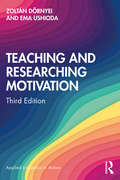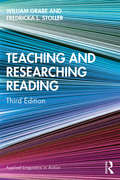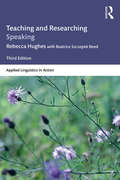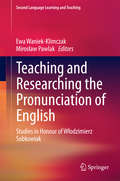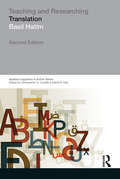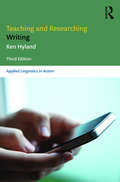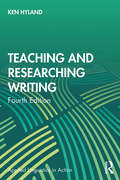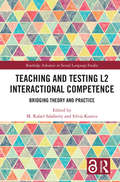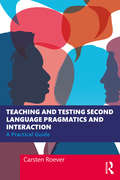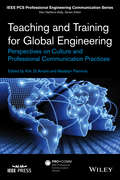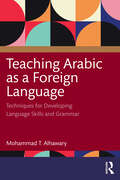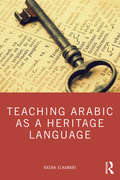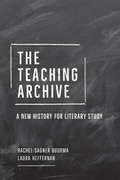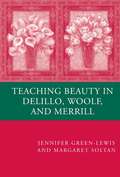- Table View
- List View
Teaching and Researching Motivation (Applied Linguistics in Action)
by Zoltán Dörnyei Ema UshiodaCultivating motivation is crucial to a language learner's success – and therefore crucial for the language teacher and researcher to understand. The third edition of Teaching and Researching Motivation reflects the dramatic changes in the field of motivation research. With an increased emphasis on dynamic perspectives on motivation and its relations with other individual, social and contextual factors, this book offers ways in which advances in the field can be put to practical use in the classroom and in research. Key new features and material: exploration of the motivation to learn languages other than English (LOTEs); principles for designing L2 motivational studies; discussion of emerging areas of research, including unconscious motivation and language learning mindsets. Providing a clear and comprehensive theory-driven account of motivation, Teaching and Researching Motivation examines how theoretical insights can be used in everyday teaching practice. The final section provides a range of useful resources, including relevant websites, key reference works and an online repository of tools and instruments for researching language learning motivation. Fully revised by pre-eminent researchers in this field, Zoltán Dörnyei and Ema Ushioda, this is an invaluable resource for teachers and researchers alike.
Teaching and Researching Reading: Third Edition (Applied Linguistics in Action)
by William Grabe Fredricka L. StollerNow in its third edition, Teaching and Researching Reading charts the field of reading (first and second language) systematically and coherently for the benefit of language teaching practitioners, students, and researchers. This volume provides background on how reading works and how reading differs for second language learners. The volume includes reading-curriculum principles, evidence-based teaching ideas, and a multi-step iterative process for conducting meaningful action research on reading-related topics. The volume outlines 14 projects for teacher adaptation and use, as well as numerous new and substantially expanded resource materials that can be used for both action research and classroom instruction.
Teaching and Researching Reading: Third Edition (Applied Linguistics in Action)
by William Grabe Fredricka L. StollerNow in its third edition, Teaching and Researching Reading charts the field of reading (first and second language) systematically and coherently for the benefit of language teaching practitioners, students, and researchers. This volume provides background on how reading works and how reading differs for second language learners. The volume includes reading-curriculum principles, evidence-based teaching ideas, and a multi-step iterative process for conducting meaningful action research on reading-related topics. The volume outlines 14 projects for teacher adaptation and use, as well as numerous new and substantially expanded resource materials that can be used for both action research and classroom instruction.
Teaching and Researching Speaking: Third Edition (Applied Linguistics in Action)
by Rebecca Hughes Beatrice Szczepek ReedTeaching and Researching Speaking provides an overview of the main approaches to researching spoken language and their practical application to teaching, classroom materials, and assessment. The history and current practices of teaching and researching speaking are presented through the lens of bigger theoretical issues about the object of study in linguistics, social attitudes to the spoken form, and the relationships between spoken and written language. A unique feature of the book is the way it clearly explains the nature of speaking and how it is researched and puts it into the context of a readable and holistic overview of language theory. This new edition is fully updated and revised to reflect the latest developments on classroom materials and oral assessment, as well as innovations in conversation analysis. The resources section is brought up-to-date with new media and currently available networks, online corpora, and mobile applications. This is a key resource for applied linguistics students, English language teachers, teacher trainers, and novice researchers.
Teaching and Researching Speaking: Third Edition (Applied Linguistics in Action)
by Rebecca Hughes Beatrice Szczepek ReedTeaching and Researching Speaking provides an overview of the main approaches to researching spoken language and their practical application to teaching, classroom materials, and assessment. The history and current practices of teaching and researching speaking are presented through the lens of bigger theoretical issues about the object of study in linguistics, social attitudes to the spoken form, and the relationships between spoken and written language. A unique feature of the book is the way it clearly explains the nature of speaking and how it is researched and puts it into the context of a readable and holistic overview of language theory. This new edition is fully updated and revised to reflect the latest developments on classroom materials and oral assessment, as well as innovations in conversation analysis. The resources section is brought up-to-date with new media and currently available networks, online corpora, and mobile applications. This is a key resource for applied linguistics students, English language teachers, teacher trainers, and novice researchers.
Teaching and Researching the Pronunciation of English: Studies in Honour of Włodzimierz Sobkowiak (Second Language Learning and Teaching)
by Ewa Waniek-Klimczak Mirosław PawlakThe book contains contributions from practitioners and theoreticians who explore the pronunciation of English from various perspectives: phonetic, phonological, psycholinguistic and sociolinguistic. In accordance with the unifying theme of the volume, individual contributions investigate the characteristics of a foreign accent, its production and perception, study the development of methods and techniques in pronunciation teaching, evaluate their use in classroom materials and in the classroom itself, and investigate the conditions for second language learning and teaching from the perspective of learners and teachers. The book offers a unique combination of a scholarly research with practical applications, inspired over the years by the work of Professor Włodzimierz Sobkowiak, who has researched pronunciation teaching and pioneered technology-oriented, corpus-based approaches to the study of English pronunciation in Poland.
Teaching and Researching Translation
by Basil A. HatimTeaching & Researching Translation provides an authoritative and critical account of the main ideas and concepts, competing issues, and solved and unsolved questions involved in Translation Studies. This book provides an up-to-date, accessible account of the field, focusing on the main challenges encountered by translation practitioners and researchers. Basil Hatim also provides readers and users with the tools they need to carry out their own practice-related research in this burgeoning new field. This second edition has been fully revised and updated through-out to include: The most up-to-date research in a number of key areas A new introduction, as well as a new chapter on the translation of style which sets out a new agenda for research in this field Updated examples and new concepts Expanded references, bibliography and further reading sections, as well as new links and resources Armed with this expert guidance, students of translation, researchers and practitioners, or anyone with a general interest in this fast-developing field can explore for themselves a range of exemplary practical applications of research into key issues and questions. Basil Hatim is Professor of Translation & Linguistics at the American University of Sharjah, UAE and theorist and practitioner in English/Arabic translation. He has worked and lectured widely at universities throughout the world, and has published extensively on Applied Linguistics, Text Linguistics, Translation/Interpreting and TESOL.
Teaching and Researching Translation
by Basil A. HatimTeaching & Researching Translation provides an authoritative and critical account of the main ideas and concepts, competing issues, and solved and unsolved questions involved in Translation Studies. This book provides an up-to-date, accessible account of the field, focusing on the main challenges encountered by translation practitioners and researchers. Basil Hatim also provides readers and users with the tools they need to carry out their own practice-related research in this burgeoning new field. This second edition has been fully revised and updated through-out to include: The most up-to-date research in a number of key areas A new introduction, as well as a new chapter on the translation of style which sets out a new agenda for research in this field Updated examples and new concepts Expanded references, bibliography and further reading sections, as well as new links and resources Armed with this expert guidance, students of translation, researchers and practitioners, or anyone with a general interest in this fast-developing field can explore for themselves a range of exemplary practical applications of research into key issues and questions. Basil Hatim is Professor of Translation & Linguistics at the American University of Sharjah, UAE and theorist and practitioner in English/Arabic translation. He has worked and lectured widely at universities throughout the world, and has published extensively on Applied Linguistics, Text Linguistics, Translation/Interpreting and TESOL.
Teaching and Researching Writing: Third Edition (Applied Linguistics in Action)
by Ken HylandThis third edition of Teaching and Researching Writing continues to build upon the previous editions’ work of providing educators and practitioners in applied linguistics with a clearly written and complete guide to writing research and teaching. The text explores both theoretical and conceptual questions, grapples with key issues in the field today, and demonstrates the dynamic relationship between research and teaching methods and practice. This revised third edition has been reorganized to incorporate new topics, including discussions of technology, identity, and error correction, as well as new chapters to address the innovative directions the field has taken since the previous edition’s publication. Boxes throughout, including "Concepts" and "Quotes", help to both reinforce readers’ understanding of the topics covered by highlighting key ideas and figures in the field, while the updated glossary and resource sections allow readers to further investigate areas of interest. This updated edition of Teaching and Researching Writing is the ideal resource for language teachers, practitioners, and researchers to better understand and apply writing research theories, methods, and practices.
Teaching and Researching Writing: Third Edition (Applied Linguistics in Action)
by Ken HylandThis third edition of Teaching and Researching Writing continues to build upon the previous editions’ work of providing educators and practitioners in applied linguistics with a clearly written and complete guide to writing research and teaching. The text explores both theoretical and conceptual questions, grapples with key issues in the field today, and demonstrates the dynamic relationship between research and teaching methods and practice. This revised third edition has been reorganized to incorporate new topics, including discussions of technology, identity, and error correction, as well as new chapters to address the innovative directions the field has taken since the previous edition’s publication. Boxes throughout, including "Concepts" and "Quotes", help to both reinforce readers’ understanding of the topics covered by highlighting key ideas and figures in the field, while the updated glossary and resource sections allow readers to further investigate areas of interest. This updated edition of Teaching and Researching Writing is the ideal resource for language teachers, practitioners, and researchers to better understand and apply writing research theories, methods, and practices.
Teaching and Researching Writing (Applied Linguistics in Action)
by Ken HylandThe new edition of Ken Hyland’s text provides an authoritative guide to writing theory, research, and teaching. Emphasising the dynamic relationship between scholarship and pedagogy, it shows how research feeds into teaching practice. Teaching and Researching Writing introduces readers to key conceptual issues in the field today and reinforces their understanding with detailed cases, then offers tools for further investigating areas of interest. This is the essential resource for students of applied linguistics and language education to acquire and operationalise writing research theories, methods, findings, and practices––as well as for scholars and practitioners looking to learn more about writing and literacy. New to the fourth edition: Added or expanded coverage of important topics such as translingualism, digital literacies and technologies, multimodal and social media writing, action research, teacher reflection, curriculum design, teaching young learners, and discipline-specific and profession-specific writing. Updated throughout––including revision to case studies and classroom practices––and discussion of Rhetorical Genre Studies, intercultural rhetoric, and expertise. Reorganised References and Resources section for ease of use for students, researchers, and teachers.
Teaching and Researching Writing (Applied Linguistics in Action)
by Ken HylandThe new edition of Ken Hyland’s text provides an authoritative guide to writing theory, research, and teaching. Emphasising the dynamic relationship between scholarship and pedagogy, it shows how research feeds into teaching practice. Teaching and Researching Writing introduces readers to key conceptual issues in the field today and reinforces their understanding with detailed cases, then offers tools for further investigating areas of interest. This is the essential resource for students of applied linguistics and language education to acquire and operationalise writing research theories, methods, findings, and practices––as well as for scholars and practitioners looking to learn more about writing and literacy. New to the fourth edition: Added or expanded coverage of important topics such as translingualism, digital literacies and technologies, multimodal and social media writing, action research, teacher reflection, curriculum design, teaching young learners, and discipline-specific and profession-specific writing. Updated throughout––including revision to case studies and classroom practices––and discussion of Rhetorical Genre Studies, intercultural rhetoric, and expertise. Reorganised References and Resources section for ease of use for students, researchers, and teachers.
Teaching and Testing L2 Interactional Competence: Bridging Theory and Practice (Routledge Advances in Second Language Studies)
by M. Rafael Salaberry Silvia KunitzThis volume features the latest research findings on L2 interactional competence to demonstrate the potential for developing and implementing research-based pedagogy that targets interactional competence (IC) in early instruction in a variety of L2 learning and teaching contexts. Incorporating contributions from both leading and emerging researchers in the area, the book is organized into four sections to provide a systematic account of interactional competence, defined as a set of skills required to co-construct an effective interaction with a variety of interlocutors in a variety of settings, and advocates for IC to be part of a well-rounded curriculum of L2 instruction. The volume provides a comprehensive overview of the different theoretical perspectives on IC within Conversation Analysis, and moves into a discussion of conversation-analytic research findings from a variety of contexts and of their pedagogical implications.The book then presents examples of pedagogy in practice and also illustrates the potential for implementing IC in testing settings. This volume makes a valuable contribution to the growing literature on interactional competence and will be of particular interest to graduate students and researchers in applied linguistics, SLA, language education, curriculum and instruction studies, and educational linguistics. Chapter 13 of this book is freely available as a downloadable Open Access PDF under a Creative Commons Attribution-Non Commercial-No Derivatives 4.0 license: https://tandfbis.s3-us-west-2.amazonaws.com/rt-files/docs/Open+Access+Chapters/9781138038998_oachapter13.pdf
Teaching and Testing L2 Interactional Competence: Bridging Theory and Practice (Routledge Advances in Second Language Studies)
by M. Rafael Salaberry Silvia KunitzThis volume features the latest research findings on L2 interactional competence to demonstrate the potential for developing and implementing research-based pedagogy that targets interactional competence (IC) in early instruction in a variety of L2 learning and teaching contexts. Incorporating contributions from both leading and emerging researchers in the area, the book is organized into four sections to provide a systematic account of interactional competence, defined as a set of skills required to co-construct an effective interaction with a variety of interlocutors in a variety of settings, and advocates for IC to be part of a well-rounded curriculum of L2 instruction. The volume provides a comprehensive overview of the different theoretical perspectives on IC within Conversation Analysis, and moves into a discussion of conversation-analytic research findings from a variety of contexts and of their pedagogical implications.The book then presents examples of pedagogy in practice and also illustrates the potential for implementing IC in testing settings. This volume makes a valuable contribution to the growing literature on interactional competence and will be of particular interest to graduate students and researchers in applied linguistics, SLA, language education, curriculum and instruction studies, and educational linguistics. Chapter 13 of this book is freely available as a downloadable Open Access PDF under a Creative Commons Attribution-Non Commercial-No Derivatives 4.0 license: https://tandfbis.s3-us-west-2.amazonaws.com/rt-files/docs/Open+Access+Chapters/9781138038998_oachapter13.pdf
Teaching and Testing Second Language Pragmatics and Interaction: A Practical Guide
by Carsten RoeverPragmatic ability is crucial for second language learners to communicate appropriately and effectively; however, pragmatics is underemphasized in language teaching and testing. This book remedies that situation by connecting theory, empirical research, and practical curricular suggestions on pragmatics for learners of different proficiency levels: It surveys the field comprehensively and, with useful tasks and activities, offers rich guidance for teaching and testing L2 pragmatics. Mainly referring to pragmatics of English and with relevant examples from multiple languages, it is an invaluable resource for practicing teachers, graduate students, and researchers in language pedagogy and assessment.
Teaching and Testing Second Language Pragmatics and Interaction: A Practical Guide
by Carsten RoeverPragmatic ability is crucial for second language learners to communicate appropriately and effectively; however, pragmatics is underemphasized in language teaching and testing. This book remedies that situation by connecting theory, empirical research, and practical curricular suggestions on pragmatics for learners of different proficiency levels: It surveys the field comprehensively and, with useful tasks and activities, offers rich guidance for teaching and testing L2 pragmatics. Mainly referring to pragmatics of English and with relevant examples from multiple languages, it is an invaluable resource for practicing teachers, graduate students, and researchers in language pedagogy and assessment.
Teaching and Training for Global Engineering: Perspectives on Culture and Professional Communication Practices (IEEE PCS Professional Engineering Communication Series)
by Kirk St. Amant Madelyn FlammiaProvides a foundation for understanding a range of linguistic, cultural, and technological factors to effectively practice international communication in a variety of professional communication arenas An in-depth analysis of how cultural factors influence translation, document design, and visual communication A review of approaches for addressing the issue of international communication in a range of classes and training sessions A summary of strategies for engaging in effective e-learning in international contexts A synopsis of how to incorporate emerging media into international teaching and training practices
Teaching and Training for Global Engineering: Perspectives on Culture and Professional Communication Practices (IEEE PCS Professional Engineering Communication Series)
by Kirk St. Amant Madelyn FlammiaProvides a foundation for understanding a range of linguistic, cultural, and technological factors to effectively practice international communication in a variety of professional communication arenas An in-depth analysis of how cultural factors influence translation, document design, and visual communication A review of approaches for addressing the issue of international communication in a range of classes and training sessions A summary of strategies for engaging in effective e-learning in international contexts A synopsis of how to incorporate emerging media into international teaching and training practices
Teaching Arabic as a Foreign Language: Techniques for Developing Language Skills and Grammar
by Mohammad T. AlhawaryTeaching Arabic as a Foreign Language: Techniques for Developing Language Skills and Grammar is an indispensable guide for in-training and novice teachers of Arabic as a foreign language and a source of fresh and effective ideas for experienced teachers. This highly practical guide outlines how Arabic second-language skills (listening, speaking, reading, and writing) and grammar are targeted in isolation from one another and how they are integrated to reinforce each other through the use of specific tried-and-tested techniques and activities. Teaching Arabic as a Foreign Language provides instantly accessible, practical teaching techniques to target and develop specific language skills and grammar at novice, intermediate, and advanced levels.
Teaching Arabic as a Foreign Language: Techniques for Developing Language Skills and Grammar
by Mohammad T. AlhawaryTeaching Arabic as a Foreign Language: Techniques for Developing Language Skills and Grammar is an indispensable guide for in-training and novice teachers of Arabic as a foreign language and a source of fresh and effective ideas for experienced teachers. This highly practical guide outlines how Arabic second-language skills (listening, speaking, reading, and writing) and grammar are targeted in isolation from one another and how they are integrated to reinforce each other through the use of specific tried-and-tested techniques and activities. Teaching Arabic as a Foreign Language provides instantly accessible, practical teaching techniques to target and develop specific language skills and grammar at novice, intermediate, and advanced levels.
Teaching Arabic as a Heritage Language
by Rasha ElHawariTeaching Arabic as a Heritage Language is a practical guide to Arabic pedagogy for Heritage Learners of Arabic. Exploring the teaching of Arabic as a foreign language (TAFL) in North America and Europe, it covers sociocultural topics such as diglossia and religion alongside theoretical approaches to Heritage Language Learning. It also provides a new and detailed definition of the heritage language learner (HLL) of Arabic. The role of the professor and the material are explored to ensure a successful learning experience. The latest advances in HLL are considered together with the recent and recommended changes in classroom practice, giving rise to the recognition of the individual needs of heritage learners. This is an indispensable resource for instructors, researchers, and students in the fields of TAFL and TASOL, as well as linguists interested in Arabic language learning and teaching.
Teaching Arabic as a Heritage Language
by Rasha ElHawariTeaching Arabic as a Heritage Language is a practical guide to Arabic pedagogy for Heritage Learners of Arabic. Exploring the teaching of Arabic as a foreign language (TAFL) in North America and Europe, it covers sociocultural topics such as diglossia and religion alongside theoretical approaches to Heritage Language Learning. It also provides a new and detailed definition of the heritage language learner (HLL) of Arabic. The role of the professor and the material are explored to ensure a successful learning experience. The latest advances in HLL are considered together with the recent and recommended changes in classroom practice, giving rise to the recognition of the individual needs of heritage learners. This is an indispensable resource for instructors, researchers, and students in the fields of TAFL and TASOL, as well as linguists interested in Arabic language learning and teaching.
The Teaching Archive: A New History for Literary Study
by Rachel Sagner Buurma Laura HeffernanThe Teaching Archive shows us a series of major literary thinkers in a place we seldom remember them inhabiting: the classroom. Rachel Sagner Buurma and Laura Heffernan open up “the teaching archive”—the syllabuses, course descriptions, lecture notes, and class assignments—of critics and scholars including T. S. Eliot, Caroline Spurgeon, I. A. Richards, Edith Rickert, J. Saunders Redding, Edmund Wilson, Cleanth Brooks, Josephine Miles, and Simon J. Ortiz. This new history of English rewrites what we know about the discipline by showing how students helped write foundational works of literary criticism and how English classes at community colleges and HBCUs pioneered the reading methods and expanded canons that came only belatedly to the Ivy League. It reminds us that research and teaching, which institutions often imagine as separate, have always been intertwined in practice. In a contemporary moment of humanities defunding, the casualization of teaching, and the privatization of pedagogy, The Teaching Archive offers a more accurate view of the work we have done in the past and must continue to do in the future.
The Teaching Archive: A New History for Literary Study
by Rachel Sagner Buurma Laura HeffernanThe Teaching Archive shows us a series of major literary thinkers in a place we seldom remember them inhabiting: the classroom. Rachel Sagner Buurma and Laura Heffernan open up “the teaching archive”—the syllabuses, course descriptions, lecture notes, and class assignments—of critics and scholars including T. S. Eliot, Caroline Spurgeon, I. A. Richards, Edith Rickert, J. Saunders Redding, Edmund Wilson, Cleanth Brooks, Josephine Miles, and Simon J. Ortiz. This new history of English rewrites what we know about the discipline by showing how students helped write foundational works of literary criticism and how English classes at community colleges and HBCUs pioneered the reading methods and expanded canons that came only belatedly to the Ivy League. It reminds us that research and teaching, which institutions often imagine as separate, have always been intertwined in practice. In a contemporary moment of humanities defunding, the casualization of teaching, and the privatization of pedagogy, The Teaching Archive offers a more accurate view of the work we have done in the past and must continue to do in the future.
Teaching Beauty in DeLillo, Woolf, and Merrill
by J. Green-Lewis M. SoltanWhat happened to beauty? How did the university literature classroom turn into a seminar on politics? Focusing on such writers as Don DeLillo, Virginia Woolf, and James Merrill, this book examines what has been lost to literature as a discipline, and to literary criticism as a practice, as a result of efforts to reduce the aesthetic to the ideological. Green-Lewis and Soltan celebrate the return of beauty as a subject in its own right to literary studies, a return all the more urgent given beauty s ability to provide not merely consolation but a sense of order and control in the context of a threatening political world.
